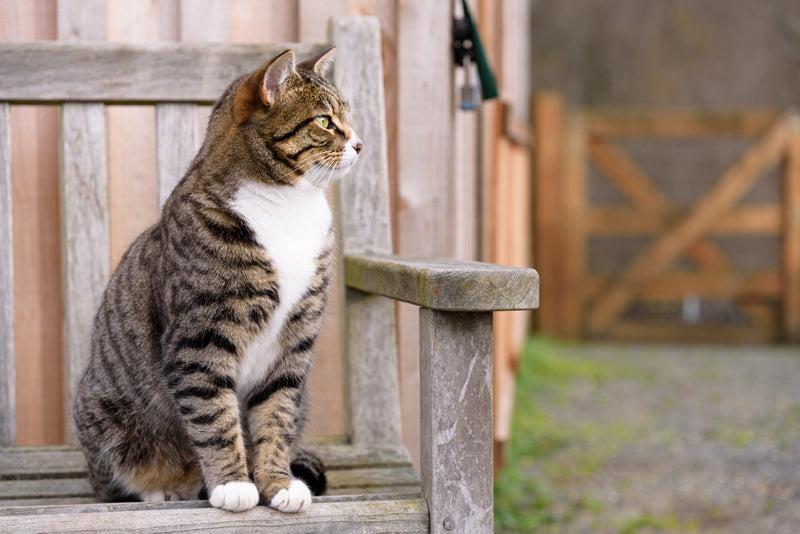Moving can be stressful for both you and your pets. But when you have an outdoor cat, the situation is especially unique. If you’re moving an outdoor cat to a new home, there are a few things you can do to help him slowly acclimate to his carrier and his new surroundings. Relocating with an outdoor cat doesn’t have to be difficult if you follow these steps.

Is Your Cat Ready to Relocate?
First, determine if your cat might be too feral to move. Some people let their cats roam outside because they’re just a little too rambunctious to stay indoors, but they’re still tame and bonded to their owners. These cats are prime candidates to relocate.
If you’re feeding a feral cat that never gets close enough to pet or if she seems more bonded to a colony of cats than to you, then you might want to reconsider moving her.1 This is also true if she’s too wild to be indoors, but you’re moving to an area that’s more dangerous outside, such as near a busy road.
For these situations, consider talking to your neighbors to see if they might be interested in providing food and water after you’re gone and becoming the new caregivers.
Get Tags and a Microchip
Read more : Choosing the Best Wood for Outdoor Furniture
Make sure your cat’s vaccines are up-to-date and consider asking your vet for a microchip if you don’t already have one. You can register the microchip online with your contact information, just in case he wanders too far in his new neighborhood.2 Keep a collar that detaches easily on him with his tags so your new neighbors know who he is.
Help Your Cat Get Used to a Carrier
Tamed outdoor cats can get used to a carrier with some patience. Put your carrier outside with a few treats or your cat’s favorite blanket or toy. Over time, outdoor scents will overcome the carrier’s strange, new scents and your cat won’t find it so scary. He might even start taking naps in the carrier.
Remember to use a carrier that attaches to a seatbelt in your car so your kitty will stay safe while you’re driving to your new home. A Travel Safety Carrier or Mod Capsule are both great options.
If your cat is a little too wild to get into a carrier, you might look into using a safe trap designed especially for cats. Leave food inside the trap to tempt your kitty; the trap automatically closes once he’s safely inside.3
Remember: when you’re traveling in the car to your new destination, keep the music low and talk soothingly to your cat. And don’t let him out of the carrier when you’re on the road.
Keep Your Cat Inside at First
Once you reach your new home, don’t just release your cat into the wild. Your kitty will be nervous and scared with all the new smells, sights, and sounds. Keep your cat indoors for at least a few days, with frequent meals so he can quickly establish some happy memories at your new home.
Read more : 9 Tips for Outdoor Pizza Oven Beginners
A great place to keep your cat for this time is the garage. The Outdoor Kitty House is an excellent way to transition your cat to the outside. It comes in heated and unheated versions so you can choose the best option for your climate. When you’re ready to move your cat outside, move the house outside too. This gives your cat some consistency in his new environment. Other places you may want to keep your cat include the laundry room, an enclosed patio, or a bathroom. Just make sure the room is safe and it won’t get too hot or too cold.
You also want to find ways to keep your cat entertained while he’s inside so he doesn’t get bored. Consider interactive toys like a Kitty Tippy Track n’ Roll, a horizontal or vertical scratcher, and a comfy bed like the Amazin’ Hooded Lounger.
Some people recommend keeping your cat indoors for as long as two weeks before allowing him outdoors alone. Cats may try to return to their old homes if they haven’t bonded with the new home yet.4
Once you allow your cat to roam outside, stay outdoors with him at first. Try to bring him back inside every night or after brief excursions for a few weeks. You might even consider letting him outside only when he hasn’t eaten for about eight hours. This will make him more eager to return when you call him back for his meal. Leave a favorite blanket outside so he can more easily follow his scent back to your new home.5
Can You Help Your Cat Become an Indoor Kitty?
If you’ve ever considered transitioning your outdoor cat to becoming an indoor cat, this would be the time to try. The days you need to leave her inside so she can get used to all the new smells and sounds could also serve as a transition period to test if she’d be happier indoors.
Moving an outdoor cat to a new home doesn’t have to be as difficult as it sounds. Just make sure you give her plenty of TLC and time indoors to adjust once you reach your destination.
- Alley Cat Allies. “Community Cat Care.” AlleyCat.org, https://www.alleycat.org/community-cat-care/safe-relocation/.
- Animal Humane Society. “Registering Your Pet’s Microchip.” AnimalHumaneSociety.org, https://www.animalhumanesociety.org/adoption/registering-your-pets-microchip.
- Alley Cat Allies. “How to Catch a Feral or Stray Cat with a Trap.” AlleyCat.org, https://www.alleycat.org/community-cat-care/tips-for-hard-to-trap-cats/.
- Stoewen, Debbie. “Moving to a New Home with Cats.” VCA Hospitals, 2019, https://vcahospitals.com/know-your-pet/moving-to-a-new-home-with-cats.
- Morris, Joan. “Tips for Moving Your Outdoor Cat to a New Home.” Mercury News, 11 August 2016, https://www.mercurynews.com/2016/07/29/tips-for-moving-your-outdoor-cat-to-new-home/.
Source: https://gardencourte.com
Categories: Outdoor


